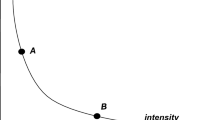Abstract
Web 2.0 applications allow rich media contents to be exposed and shared by users. Nevertheless, usually, a multimedia is provided as an unicum, made by synchronized media items. Sound tracks, video sequences, captions, cannot be customized “on-the-fly” by users. Managing multimedia in a deep way would meet the expectations of nowadays Web prosumers (i.e. producers and consumers), and it would widen the audience. Describing and synchronizing each medium, as well as specifying different alternative contents for it, are the keystones of multimedia customization and of audience widening. This paper presents a multimedia collaborative system, which provides support to the arrangement of medium into a multi-views composed multimedia. Each prosumer can add medium by juxtaposition or by defining it as an alternative (audio, video, textual) version of an existing one. The implementation of such a system is based on SMIL 3.0 specification but implements a new and compact syntax to let users manipulate the original multimedia synchronization and their alternatives. The proposed approach has been put to test in two different scenarios.










Similar content being viewed by others
References
Bulterman DCA et al (2006) An architecture for viewer-side enrichment of TV content, presented at the 14th annual ACM international conference on Multimedia (MM’06), Santa Barbara, CA,USA, pp 651–654, Oct
Cattelan RG et al (2008) Watch-and-comment as a paradigm toward ubiquitous interactive video editing. ACM Transactions on Multimedia Computing, Communications and Applications 4(4), Article 28, Oct
Cesar P et al (2008) Enhancing social sharing of videos: fragment, annotate, enrich, and share, presented at the 16th ACM international conference on Multimedia (MM’08), Vancouver, British Columbia, Canada, pp 11–20, Oct
Désilets A et al (2006) Translation the Wiki way, presented at the 2006 ACM International Symposium on Wikis (WikiSym 2006), Odense, Denmark, August 21–23
Facebook (2009) Available: http://www.facebook.com/
Ferretti S et al (2008) E-learning 2.0: you are We-LCoME!, presented at the 2008 W4A International Cross-Disciplinary Conference on Web Accessibility, Beijing, China, April 21–22
Foll S et al (2006) Classifying multimedia resources using social relationships, presented at the Eighth IEEE International Symposium on Multimedia (ISM’06), San Diego, CA, USA, Dec 11–13
GoogleVideo (2009) Available: http://video.google.com/
Hossain MA et al (2006) MeTaMaF: Metadata tagging and mapping framework for managing multimedia content, presented at the Eighth IEEE International Symposium on Multimedia (ISM’06), San Diego, CA, USA, Dec 11–13
IMS Global Learning Consortium (2006) Guidelines for developing accessible learning applications. Available: http://www.imsglobal.org/accessibility/
IMS Global Learning Consortium, IMS AccessForAll Meta-Data (ACCMD) (2004) Available from: http://www.imsglobal.org/specificationdownload.cfm
Italian parliament (2004) Law nr. 4–01/09/2004. Official Journal nr. 13–01/17/2004, Jan
Jansens J et al (2008) Enabling adaptive time-based web applications with SMIL state, presented at the 8th ACM symposium on Document engineering (DocEng’08), São Paulo, Brazil, pp 18–27, Sep
Kosch H et al (2005) The life cycle of multimedia metadata. IEEE Multimed 12(1):80–86
Monteiro de Resende Costa R et al (2006) Live editing of hypermedia documents, presented at the 6th ACM symposium on Document engineering (DocEng’06), Amsterdam, The Netherlands, pp 165–172, Oct
MPEG Requirements Group (2002) MPEG-21 Overview”. ISO/MPEG N4991
MySpace (2009) Available: http://www.myspace.com/
Nack F et al (2004) That obscure object of desire: multimedia metadata on the web, Part 2. IEEE Multimed 12(1):54–63
Nested Context Language (NCL) (2009) Available: http://www.ncl.org.br/index_en.php
Pea R et al (2004) The diver project: interactive digital video repurposing. IEEE Multimed 11(1):54–61
Sgouros NM et al (2007) Towards open source authoring and presentation of multimedia content, presented at the International workshop on Human-centered multimedia (HCM’07), Augsburg, Bavaria, Germany, pp 41–46, Sep
Shaw R et al (2006) Community annotation and remix: a research platform and pilot deployment, presented at the 1st ACM international workshop on Human-centered multimedia (HCM’06), Santa Barbara, CA, USA, pp. 89–98, Oct
SMIL 3.0 Daisy Profile Module (2009) Available: http://www.w3.org/TR/SMIL/smil-daisy-profile.html
Tang CW (2007) Spatiotemporal visual considerations for video coding. IEEE Trans Multimedia 7(2):231–238
The Ambulant Open Source SMIL player (2009) Available: http://www.ambulantplayer.org/
Van Ossenbruggen J et al (2004) That obscure object of desire: multimedia metadata on the web, Part 1. IEEE Multimed 11(4):38–48
World Wide Web Consortium (1999) Accessibility features of SMIL. Available: http://www.w3.org/TR/SMIL-access/, Sep
World Wide Web Consortium (2008) Synchronized multimedia integration language 3.0. Available: http://www.w3.org/TR/2008/REC-SMIL3-20081201/, Dec
World Wide Web Consortium (2008) The SMIL 3.0 CustomTestAttributes Module. Available: http://www.w3.org/TR/2008/REC-SMIL3-20081201/smil-content.html#ContentControlNS-UserGroups/, Dec
World Wide Web Consortium (2008) SMIL 2.1 Timing and Synchronization Module. Available: http://www.w3.org/TR/2008/REC-SMIL3-20081201/smil-timing.html, (Dec 01)
World Wide Web Consortium (2008) Web content accessibility guidelines 2.0. Available: http://www.w3.org/TR/WCAG20/, Dec
X-smiles (2009) Available: http://www.x-smiles.org/
YouTube (2009) Available: http://www.youtube.com/
Author information
Authors and Affiliations
Corresponding author
Rights and permissions
About this article
Cite this article
Mirri, S., Muratori, L.A., Roccetti, M. et al. The Directors’ cut: a solution to collaborative multimedia management. Multimed Tools Appl 53, 319–344 (2011). https://doi.org/10.1007/s11042-010-0533-z
Published:
Issue Date:
DOI: https://doi.org/10.1007/s11042-010-0533-z




